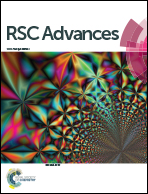pH-Responsive nanovalves based on encapsulated halloysite for the controlled release of a corrosion inhibitor in epoxy coating
Abstract
Halloysite nanotubes (HNTs) were applied as corrosion inhibitor (benzotriazole, BTA) hosts, which were encapsulated by using tetraethyl orthosilicate (TEOS) and modified by (3-aminopropyl)triethoxysilane (APTES). The modified nanocontainers were dispersed in the epoxy matrix, resulting in a functional composite coating. The structure of the assembly of the modified HNTs was characterized by FT-IR, XRD, XPS and TEM. Furthermore, the amount of BTA loaded in the lumen of the HNTs was determined by TGA. Such modified HNTs were well dispersed in ethanol and epoxy resin which was confirmed by SEM and EDS. A reasonable release rate of the corrosion inhibitor from the nanocontainers was realized by controlling the pH value (pH = 3) and monitoring the range between 30 and 450 min with UV-vis. Compared to the pure epoxy coating, the anticorrosive performance of the coating loaded with 3% of HNTs-entrapped BTA was tested by an EIS method on a steel matrix (N80) and it showed remarkable improvement. Furthermore, the simulated inhibiting behavior of inhibitor release from the nanocontainers in composite coatings was investigated by scarification tests in 10 wt% NaCl solution (pH = 3). The result demonstrated that the corrosion inhibitor releasing nanocontainers played a key role in protecting the substrate.


 Please wait while we load your content...
Please wait while we load your content...